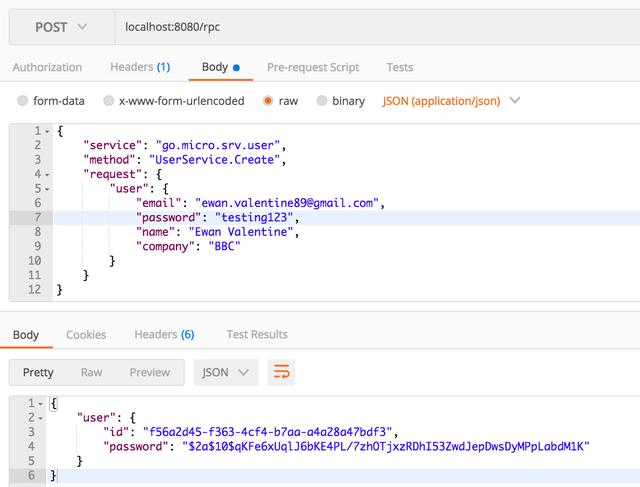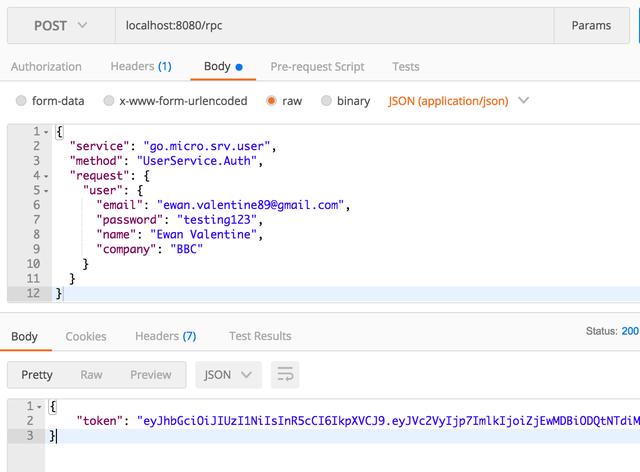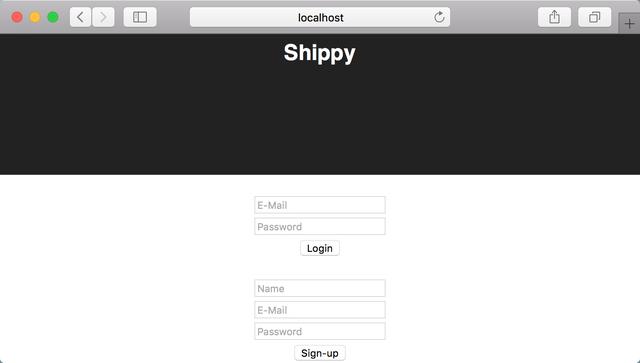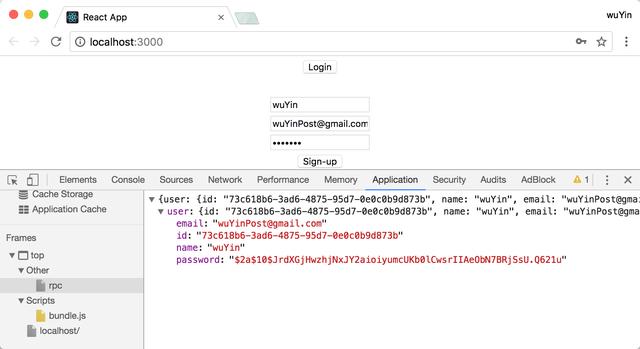Golang 微服务 教程(六)
阅读次数: 2785 | 字数统计: 2,329
原文链接:ewanvalentine.io,翻译已获作者 Ewan Valentine 授权。
本文完整代码:
在上节中我们使用 go-micro 搭建了微服务的事件驱动架构。本节将揭晓从 web 客户端的角度出发如何与微服务进行调用交互。
微服务与 web 端交互
参考 go-micro 文档,可看到 go-micro 实现了为 web 客户端代理请求 RPC 方法的机制。
内部调用
微服务 A 调用微服务 B 的方法,需要先实例化再调用:bClient.CallRPC(args…),数据作为参数传递,属于 内部调用 。
外部调用
web 端浏览器是通过 HTTP 请求去调用微服务的方法,go-micro 就做了中间层,调用方法的数据以 HTTP 请求的方式提交,属于 外部调用 。
REST vs RPC
REST 风格多年来在 web 开发领域独领风骚,常用于客户端与服务端进行资源管理,应用场景比 RPC 和 SOAP 都要广得多。更多参考:知乎:RPC 与 RESTful API 对比
REST
REST 风格对资源的管理既简单又规范,它将 HTTP 请求方法对应到资源的增删改查上,同时还可以使用 HTTP 错误码来描述响应状态,在大多数 web 开发中 REST 都是优秀的解决方案。
RPC
不过近年来 RPC 风格也乘着微服务的顺风车逐渐普及开来。REST 适合同时管理不同的资源,不过一般微服务只专注管理单一的资源,使用 RPC 风格能让 web 开发专注于各微服务的实现与交互。
Micro 工具箱
我们从第二节开始就一直在使用 go-micro 框架,现在来看看它的 API 网关。go-micro 提供 API 网关给微服务做代理。API 网关把微服务 RPC 方法代理成 web 请求,将 web 端使用到的 URL 开放出来,更多参考:go-micro toolkits,go-micro API example
使用
# 安装 go-micro 的工具箱: # $ go get -u github.com/micro/micro # 我们直接使用它的 Docker 镜像 $ docker pull microhq/micro
现在修改一下 user-service 的代码:
package main
import (
"log"
pb "shippy/user-service/proto/user"// 作者用的另一个仓库
"github.com/micro/go-micro"
)
func main() {
// 连接到数据库
db, err := CreateConnection()
defer db.Close()
if err != nil {
log.Fatalf("connect error: %v\n", err)
}
repo := &UserRepository{db}
// 自动检查 User 结构是否变化
db.AutoMigrate(&pb.User{})
// 作者使用了新仓库 shippy-user-service
// 但 auth.proto 和 user.proto 定义的内容是一致的
// 修改 shippy.auth 为 go.micro. srv .user 即可
// 注意 API 调用参数也需对应修改
srv := micro.NewService(
micro.Name("go.micro.srv.user"),
micro.Version("latest"),
)
srv.Init()
// 获取 broker 实例
// pubSub := s.Server().Options().Broker
publisher := micro.NewPublisher(topic, srv.Client())
t := TokenService{repo}
pb.RegisterUserServiceHandler(srv.Server(), &handler{repo, &t, publisher})
if err := srv.Run(); err != nil {
log.Fatalf("user service error: %v\n", err)
}
}
原代码 仓库:shippy-user-service/tree/tutorial-6
API 网关
现在把 user-service 和 emil-service 像上节一样 make run 运行起来。之后再执行:
$ docker run -p 8080:8080 \ -e MICRO_REGISTRY=mdns \ microhq/micro api \ --handler=rpc \ --address=:8080 \ --namespace=shippy
API 网关现在运行在 8080 端口,同时告诉它和其他微服务一样使用 mdns 做服务发现,最后使用的命名空间是 shippy,它会作为我们服务名的前缀,比如 shippy.auth,shippy. email ,默认值是 go.micro.api,如果不指定而使用默认值将无法生效。
web 端创建用户
现在外部可以像这样调用 user-service 创建用户的方法:
$ curl -XPOST -H 'Content-Type: application/ JSON ' \ -d '{ "service": "shippy.auth", "method": "Auth.Create", " request ": { "user": { "email": "ewan.valentine89@gmail.com", "password": "testing123", "name": "Ewan Valentine", "company": "BBC" } } }' \
效果如下:

在这个 HTTP 请求中,我们把 user-service Create 方法所需参数以 JSON 字段值的形式给出,API 网关会帮我们自动调用,并同样以 JSON 格式返回方法的处理结果。
web 端认证用户
$ curl -XPOST -H 'Content-Type: application/json' \
-d '{
"service": "shippy.auth",
"method": "Auth.Auth",
"request": {
"email": "your@email.com",
"password": "SomePass"
}
}' \
运行效果如下:

用户界面
现在将上边的 API 做成 web 端调用,我们这里使用 React 的 react-create-app 库。先安装:$ npm install -g react-create-app,最后创建项目:$ react-create-app shippy-ui
App.js
// shippy-ui/src/App.js
import React, { Component } from 'react';
import './App.css';
import CreateConsignment from './CreateConsignment';
import Authenticate from './Authenticate';
class App extends Component {
state = {
err: null,
authenticated: false,
}
onAuth = (token) => {
this.setState({
authenticated: true,
});
}
renderLogin = () => {
return (
<Authenticate onAuth={this.onAuth} />
);
}
renderAuthenticated = () => {
return (
<CreateConsignment />
);
}
getToken = () => {
return localStorage.getItem('token') || false;
}
isAuthenticated = () => {
return this.state.authenticated || this.getToken() || false;
}
render() {
const authenticated = this.isAuthenticated();
return (
<div className="App">
<div className="App-header">
<h2>Shippy</h2>
</div>
<div className='App-intro container'>
{(authenticated ? this.renderAuthenticated() : this.renderLogin())}
</div>
</div>
);
}
}
export default App;
接下来添加用户认证、货物托运的两个组件。
Authenticate 用户认证组件
// shippy-ui/src/Authenticate.js
import React from 'react';
class Authenticate extends React.Component {
constructor(props) {
super(props);
}
state = {
authenticated: false,
email: '',
password: '',
err: '',
}
login = () => {
fetch(``, {
method: 'POST',
headers: {
'Content-Type': 'application/json',
},
body: JSON.stringify({
request: {
email: this.state.email,
password: this.state.password,
},
// 注意
// 作者的把 Auth 认证作为了独立的项目
// Auth 其实和 go.micro.srv.user 是一样的
// 这里作者和译者的代码略有不同
service: 'shippy.auth',
method: 'Auth.Auth',
}),
})
.then(res => res.json())
.then(res => {
this.props.onAuth(res.token);
this.setState({
token: res.token,
authenticated: true,
});
})
.catch(err => this.setState({ err, authenticated: false, }));
}
signup = () => {
fetch(``, {
method: 'POST',
headers: {
'Content-Type': 'application/json',
},
body: JSON.stringify({
request: {
email: this.state.email,
password: this.state.password,
name: this.state.name,
},
method: 'Auth.Create',
service: 'shippy.auth',
}),
})
.then((res) => res.json())
.then((res) => {
this.props.onAuth(res.token.token);
this.setState({
token: res.token.token,
authenticated: true,
});
localStorage.setItem('token', res.token.token);
})
.catch(err => this.setState({ err, authenticated: false, }));
}
setEmail = e => {
this.setState({
email: e.target.value,
});
}
setPassword = e => {
this.setState({
password: e.target.value,
});
}
setName = e => {
this.setState({
name: e.target.value,
});
}
render() {
return (
<div className='Authenticate'>
<div className='Login'>
<div className='form-group'>
<input
type="email"
onChange={this.setEmail}
placeholder='E-Mail'
className='form-control' />
</div>
<div className='form-group'>
<input
type="password"
onChange={this.setPassword}
placeholder='Password'
className='form-control' />
</div>
<button className='btn btn-primary' onClick={this.login}>Login</button>
<br /><br />
</div>
<div className='Sign-up'>
<div className='form-group'>
<input
type='input'
onChange={this.setName}
placeholder='Name'
className='form-control' />
</div>
<div className='form-group'>
<input
type='email'
onChange={this.setEmail}
placeholder='E-Mail'
className='form-control' />
</div>
<div className='form-group'>
<input
type='password'
onChange={this.setPassword}
placeholder='Password'
className='form-control' />
</div>
<button className='btn btn-primary' onClick={this.signup}>Sign-up</button>
</div>
</div>
);
}
}
export default Authenticate;
CreateConsignment 货物托运组件
// shippy-ui/src/CreateConsignment.js
import React from 'react';
import _ from 'lodash';
class CreateConsignment extends React.Component {
constructor(props) {
super(props);
}
state = {
created: false,
description: '',
weight: 0,
containers: [],
consignments: [],
}
componentWillMount() {
fetch(``, {
method: 'POST',
headers: {
'Content-Type': 'application/json',
},
body: JSON.stringify({
service: 'shippy.consignment',
method: 'ConsignmentService.Get',
request: {},
})
})
.then(req => req.json())
.then((res) => {
this.setState({
consignments: res.consignments,
});
});
}
create = () => {
const consignment = this.state;
fetch(``, {
method: 'POST',
headers: {
'Content-Type': 'application/json',
},
body: JSON.stringify({
service: 'shippy.consignment',
method: 'ConsignmentService.Create',
request: _.omit(consignment, 'created', 'consignments'),
}),
})
.then((res) => res.json())
.then((res) => {
this.setState({
created: res.created,
consignments: [...this.state.consignments, consignment],
});
});
}
addContainer = e => {
this.setState({
containers: [...this.state.containers, e.target.value],
});
}
setDescription = e => {
this.setState({
description: e.target.value,
});
}
setWeight = e => {
this.setState({
weight: Number(e.target.value),
});
}
render() {
const { consignments, } = this.state;
return (
<div className='consignment-screen'>
<div className='consignment-form container'>
<br />
<div className='form-group'>
<textarea onChange={this.setDescription} className='form-control' placeholder='Description'></textarea>
</div>
<div className='form-group'>
<input onChange={this.setWeight} type='number' placeholder='Weight' className='form-control' />
</div>
<div className='form-control'>
Add containers...
</div>
<br />
<button onClick={this.create} className='btn btn-primary'>Create</button>
<br />
<hr />
</div>
{(consignments && consignments.length > 0
? <div className='consignment-list'>
<h2>Consignments</h2>
{consignments.map((item) => (
<div>
<p>Vessel id: {item.vessel_id}</p>
<p>Consignment id: {item.id}</p>
<p>Description: {item.description}</p>
<p>Weight: {item.weight}</p>
<hr />
</div>
))}
</div>
: false)}
</div>
);
}
}
export default CreateConsignment;
UI 的完整代码可见:shippy-ui
现在执行 npm start,效果如下:

打开 Chrome 的 Application 能看到在注册或登录时,RPC 成功调用:

总结
本节使用 go-micro 自己的 API 网关,完成了 web 端对微服务函数的调用,可看出函数参数的入参出参都是以 JSON 给出的,对应于第一节 Protobuf 部分说与浏览器交互 JSON 是只选的。此外,作者代码与译者代码有少数出入,望读者注意,感谢。
下节我们将引入 Google Cloud 云平台来托管我们的微服务项目,并使用 Terraform 进行管理。


